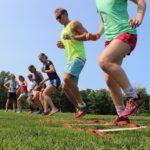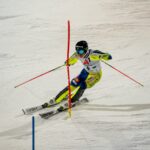 If you’re at all serious about your ski racing, this past summer should have been devoted to the process of making yourself the best ski racer you can be. There is one thing that you better have done and another thing that you likely will have done this past summer: engage in an intensive physical conditioning program and spend time on snow, respectively. These last several months gave you an essential opportunity to devote large blocks of time to making gains in your fitness and in the technical and tactical aspects of your skiing with no concern for results, quotas, points, or rankings. I also hope you will have heeded my constant message to train your mind and get it into great shape as well!
If you’re at all serious about your ski racing, this past summer should have been devoted to the process of making yourself the best ski racer you can be. There is one thing that you better have done and another thing that you likely will have done this past summer: engage in an intensive physical conditioning program and spend time on snow, respectively. These last several months gave you an essential opportunity to devote large blocks of time to making gains in your fitness and in the technical and tactical aspects of your skiing with no concern for results, quotas, points, or rankings. I also hope you will have heeded my constant message to train your mind and get it into great shape as well!
It’s hard to believe that the summer is over and that I’ll be joining many of you on snow in Colorado over the next three months. With Labor Day just a week away, we have entered a new phase of preparation for the coming race season that is equally as essential as your summer efforts to your achieving your ski racing goals for the upcoming race season.
Think of your skiing this season as a painting of yourself as the ski racer you want to be this coming winter that you began in the spring and must finish before you climb into the starting gate in your first race of the year a few months from now. The summer was about broad strokes in which the “image” of how you want to ski begins to take shape. You use a wide paintbrush and make broad strokes as the basic image of your skiing becomes evident. But the painting lacks detail and is far from a finished product.
The fall is the time to use a fine paintbrush and fill in the details of your self-portrait. As your first race approaches, the clear and precise image that you have of your skiing in your mind should be realized on the canvas. When that first race arrives, you should be able to look at that painting and see an image of precisely the kind of skier you want to be this race season.
So, to continue my artistic metaphor, what should you have on your palette that will enable you to create a masterpiece of fast skiing?
Physical Conditioning
Your physical training should take on richer colors or more detail. There should be a greater emphasis on quality over quantity (though you certainly need to maintain a good degree of volume). This involves getting the most out of your conditioning efforts that will result in your being the most fitness version of you there has ever been. This shift also reduces the chances of burnout or injury at a time when you need to be healthy and rested.
You can increase the quality of your physical training and, at the same time, further develop your mental skills by understanding that mental training starts in the gym. This involves thinking about what enables you to ski your best in on-snow training and applying those same skills and habits to your conditioning:
- Confidence: Make positive statements about your ability to achieve your training goal for that set (e.g., “I am going to do 10 reps.”).
- Commitment: Dedicate yourself to giving your fullest effort every rep and to finishing the set strong.
- Intensity: Match your physical intensity to your exercise. If you’re doing power squats, you want to actively increase your intensity before you step under the bar. If you are doing yoga, you want to actively relax your body.
- Focus: Narrow your attention onto whatever will help you fully execute the exercise. The focus could be technical (e.g., hips forward) or mental (e.g., explode).
- Breathing: Match your breathing to your exercise. If you are doing power training, your breathing should be more intense. If you are doing flexibility training, it should be calmer and slower.
Mental Imagery
Mental imagery is another way to add color and depth to your developing masterpiece that is your skiing. By now, you’re probably sick of me bringing this up all the time, but I will say it again. Mental imagery is the most important mental tool available to you. And if you haven’t developed an organized and consistent off-snow mental imagery program, you’re not going to be the best ski racer you can be.
The fall is an ideal time to make a real commitment to mental imagery because it allows you to get a ton of miles on snow and in gates (in your mind) before you actually get back on snow and back into gate training. You can more deeply ingrain technically sound and fast skiing with mental imagery, so, when the snow flies, it will be as if you’ve been skiing all fall and you can continue your skiing development from your first day on snow.
Here’s what you should do with mental imagery:
- Choose one or two technical (e.g., wider stance), tactical (e.g., higher line), mental (e.g., relaxing at the start), or performance (e.g., fast skiing) areas you want to focus on in your imagery.
- Create a ladder of training and race scenarios, from training courses on your home hill to low-level races to your most important races of the season.
- Set aside a specific time each day three times a week.
- In each imagery session, get comfortable, close your eyes, take five deep breaths, and then guide yourself through two training or race runs (I also have mp3 audio recordings that can guide you through these scenarios) incorporating your imagery goals (see #1 above) into your imagined skiing.
- Stay committed and consistent with your imagery throughout the fall.
The Grind of Winter
The long winter of training and racing is incredibly taxing physically and mentally. Another important goal for the fall is to prepare yourself to stay healthy and rested from your first turns of the season until your last. The habits you establish in the fall will, hopefully, carry you through the winter with strength and stamina.
These habits you instill in the coming months should include:
- Sufficient and consistent sleep (young people don’t get enough sleep these days)
- Healthy eating (food fuels or contaminates your body)
- Good study habits (stress in school will hurt your skiing)
- Making your ski racing a priority over other interests (don’t let poor choices hurt your skiing)
- Balanced use of technology (which threatens sleep and distracts you)
What you do this fall will have a big impact on how you ski this winter. Using what I’ve just described above, as well as advice from your coaches and parents, take the fall to paint a picture of yourself as a ski racer that, at the end of the race season, you can look at pride and awe.





